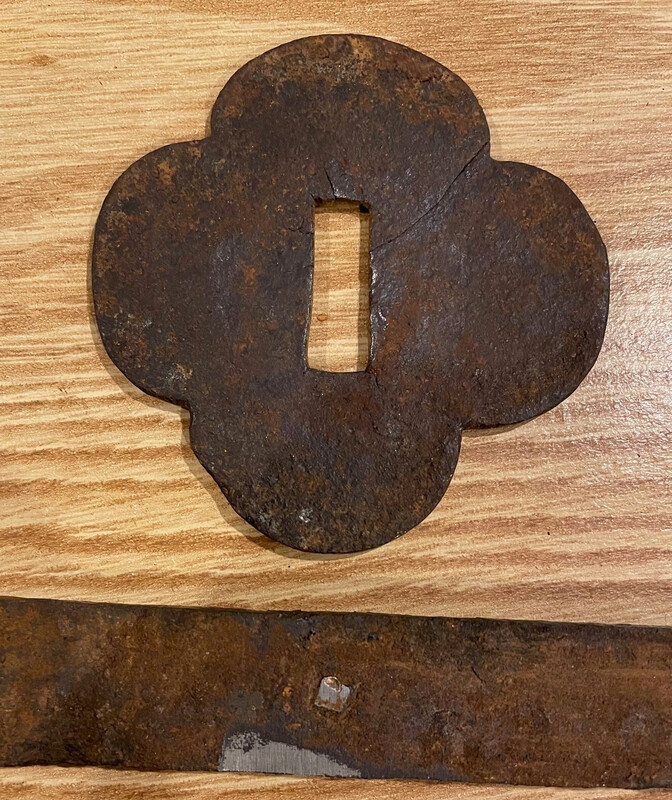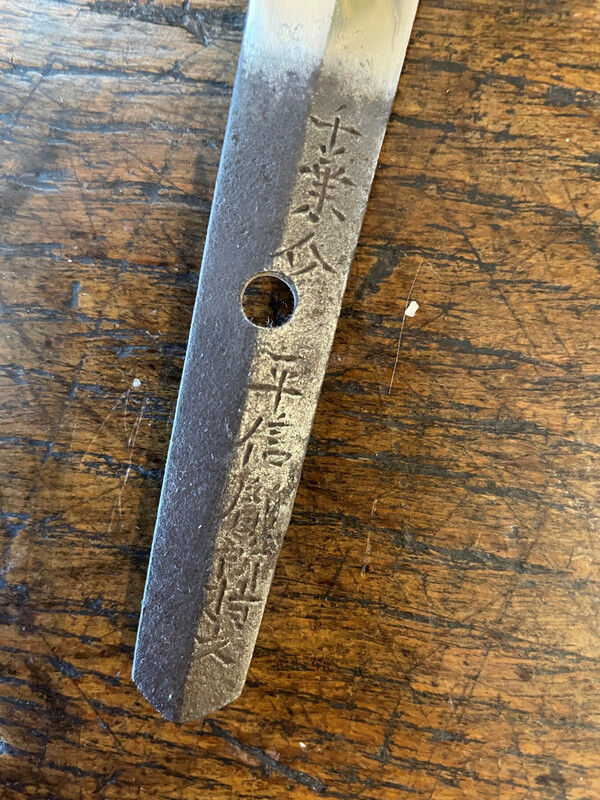
Peter Bleed
Gold Tier-
Posts
1,848 -
Joined
-
Last visited
-
Days Won
8
Content Type
Profiles
Forums
Events
Store
Downloads
Gallery
Everything posted by Peter Bleed
-
Help with Mei and Nengo on Tanto.
Peter Bleed replied to tbonesullivan's topic in Translation Assistance
this view also makes the 5 seem more - ahhh - normal. P -
neat, - 1938 date and all.
-
The fact that they did NOT say "SUKESADA" suggests that this blade is better than a mass produced, kazu-uchi mono. P
-
I think the paper says, "Den Bizen Osafune Tadamitsu" so it is in the style of a Bizen smith ... like ...Tadamitsu. This seems like a general assessment for a blade that is hardly "Bad" but also hardly remarkable. There were armies that needed arms at that point... Peter
-
Translation help on gendai sword
Peter Bleed replied to matthewbrice's topic in Translation Assistance
interesting sword! Peter -
Not Your Usual Translation Request
Peter Bleed replied to Bruce Pennington's topic in Translation Assistance
Once again, I am moved by the richness of Colorado culture. -
I agree with your comments, Ron, BUT this guard looks BETTER (IMHO) than a standard Soten - while using and presenting very Soten material - solder applied faces, classic sages motif, and blue/black finish. Can it be that this guard is TOO free and original to fit the "established categories"? Peter
-
Barry, This is a challenge Seki ju Nawai Kane (??? sen??)
-
Well, gee, Stephen. At the posted price this seems very interesting, but I assume we have not seen the "last bid." Hokke-sama was a really nice guy. I recall the first time time visited him (I wore my best pants and had him shower me with sparks, but that is another story. At that time there were NO pants my size available in Japan. But, to continue,....In his forge I saw a couple of clealry old blades that were somehow "in process." I didn't understand - - - and it seemed suspicious - - - so I asked and he said - directly and with no hedging , that he retempered Bizen blades. The bit of research you have led us to, Stephen, says that he started his career working in the Bizen style and followed it until he changed hisname and went Yamato. So, tell, Stephen. What do you think this sword will sell for....?
-
Well, gee. Stephen, another one of these! By that I mean, WOW. Kagefusa was a initial signature of Hokke Saburo Nobufusa. It looks like it was associated with Bizen style work, which is to say it was before Hokke-sama caught Yamato-den. So tell us why you are looking at a toroku-sho for this blade. Peter
-
Mekugi, the real secret of Japanese blades?
Peter Bleed replied to Peter Bleed's topic in General Nihonto Related Discussion
Good eye, Bazz, but the flaws do NOT cut straight across the plate. They show up on the opposite face but are well-below where they start out. I think they are just crappy "lamination". If I ever swing another trip to Aus, I'll bring this guard along to show you! (But that will require you to come out west of Hoppers Crossing). Peter -
Mekugi, the real secret of Japanese blades?
Peter Bleed replied to Peter Bleed's topic in General Nihonto Related Discussion
Comments by Grev and Chris invite consideration of the guard on this Chinese weapons. As Grev points out, the guard has a rather large, rectangular slot - what WE would call a nakago-ana, but who knows what it was called in China. Interestingly, this guard shows a number of large, coarse forging flaws. Evidence of laminations are to be seen on Japanese katchuchi/tosho tsuba, but these seem - ahhh - remarkable!. Peter -
About a year ago at a local gun show I acquired a “Chinese polearm.” It was a boredom buy since I really have neither interest nor knowledge of Chinese weapons, but I think this is of a type that is commonly called a ‘Dao’. It came with no history and truly can be described as “in relic condition.” It sat quietly in a closet until last week when I began thinking – yet again – about “Namban sword guards” which, of course, includes a great range of Southeast and East Asian, European, and Japanese fittings that were re-purposed, traded, and variously mixed. In thinking about that topic, I decided that the best element on the Dao was its lobed guard that seems comparable to “early” Japanese tsuba. The flow of arms between Japan and China is well known. To study that fitting, I set about disassembling the pole arm. I assumed that experience with Japanese arms would offer a basis for this activity. What I discovered was the importance of “MEKUGI” the bamboo pins that hold Japanese blades together. I also came to the conclusion that Chinese construction seems to have been significantly different – and less refined – than Japanese techniques. The tang of the Dao blade was rather loosely set in an open groove in the short section of pole still present. It looks like the pole had been sawed off just beyond the end of the tang. In addition to 4 forged iron rings, the tang was held in place by two (2) iron pins. Based on experience with Japanese polearms, I assumed that these would be comparable to the bamboo pins used in Japan and that they would be removable. In fact, I discovered that the iron pins were essentially fixed. They seemed to have become solidly “rusted” on to the Dao tang. Even heavy (but careful) pounding would not loosen them. Having committed to the project, I decided to cut the iron pin with a thin blade Dremel tool. The take away message may be that bamboo mekugi allowed Japanese blades to be removable, and therefore survivable. Are they, in fact, the real secret behind Japanese blades? Peter
-
Help with Ko-Wakizashi by Kanemitsu Mei
Peter Bleed replied to tbonesullivan's topic in Translation Assistance
An interesting bit of adventure here. I think Steve is correct with KANEKIYO" but I got out the Sendai list to make sure that the tag wasn't for one of the Sendai Kanes. It isn't! Peter -
NBTHK moving into technological era
Peter Bleed replied to Gakusee's topic in General Nihonto Related Discussion
I am glad to see that others got this message and found it as - potentially - positive. Truth to tell, I had more questions than answers after getting the letter.They WILL accept international shinsa submissions, BUT I am not sure HOW that will be done. Will the organization oversee the toroku and transport? We will still need an agent, right? It strikes me that bringing a shinsa team TO THE SWORDS (!) would be a much easier way of managing international shinsa. Peter -
I was kind of thinking it was a TANE, but I can't do anything with that guess. Please let me take me that this opportunity to say THANKS to NMB. Thank you Steve and Jussi! P
-
Friends! This ken tanto recently came home with a new shirasaya. I like it a lot, but having scratched my head over the mei, I would appreciate the insights of the community. Please! Peter
-
What did they do with yari/naginata saya?
Peter Bleed replied to JH Lee's topic in General Nihonto Related Discussion
Bushi with polearms weren't expected to survive. They needed no provision for preserving their weapon. That may be why - in collecting values - naginata are considered below katana, and yari are, well, just not there. Peter -
Gee, it looks to me like it says "Bizen" - a district not a signature. Is it ceramic? P
-
This has been a consistently interesting thread. Thank you all! Having said that, and acknowledging that I am NOT a tsuba collector, (well, I sort of DO have a bunch of Namban guards, but...) I keep coming back to the basic fact that these things are the "tie-tacks and cufflinks" of the Edo period. How can WE understand the quality of these objects without embracing the foibles of their era? Peter
-
Steve, Thank you, "YES" I see the resemblance. And I assume that this sword was made by a fellow named Sukekuni. Your help and guidance is always important to us. In this case the swordsmith may have been aiming at a distinctive style, but to my eye it does not look to have been skillfully rendered. And this kind of stylistic refinement hardly seems worthy the moment, especially when it turns out that the smith went back to the BOX Kuni a month later. Peter
-
I can't get a "Kuni" out of this nakago. And IMHO the suke part is pretty dodgy. In a real sense, tho, that doesn't matter. What this sword tells me about is 1) the tragedy of Japan's involvement in the War, with them trying to produce swords when aircraft carriers and tanks were deciding the conflict, and 2) the clear evidence that swordsmithing in Japan is a complex - well- "art" that involves thorough mastery of blacksmithing and tangential crafts like signing an art name with a chisel. I find this sword tragic. Peter
-
Franco lays out nice, concrete characteristics of “collectible” swords. To his list, I would add that main lines are always much more desirable than the work of documented deshi or later generations. Major smiths always had and maintained a corps of guys who “studied” and supported the main man. Presumably, these smiths went on to fulfill the blade needs of their communities, but as far as I can tell, “school” blades are ‘slow movers’ except maybe in their home towns. Peter
-
Interesting thread and a GREAT application of NMB. Thank you all! Peter
-
The paper suggests that this sword dates from what would be called the late Edo period, the so-called "Shin-shinto era." Swords like this are commonly traded on the collectors' market. They are out there. I urge you to meet and visit with other collectors. That is a good way of meeting new people, learning, and seeing swords. Enjoy! Peter







